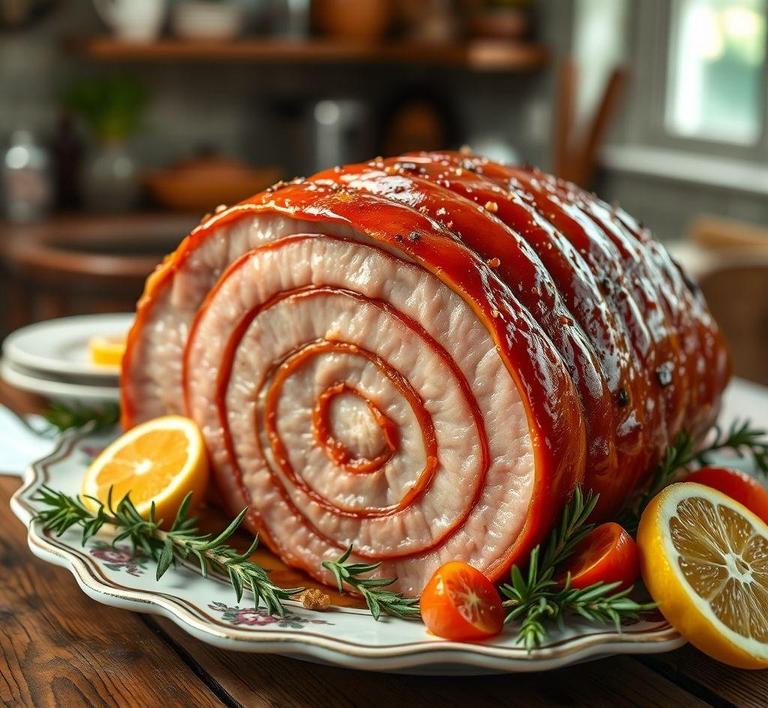Refreezing spiral ham can be a bit tricky, but it’s definitely doable if you follow the right steps. Whether you have leftovers from a holiday feast or simply bought too much for a gathering, knowing how to safely refreeze spiral ham is key to keeping it tasty and safe to eat later. Spiral ham, with its tender texture and savory flavor, is a favorite for many, but it’s important to make sure it’s stored correctly to maintain its quality. In this guide, we’ll walk you through everything you need to know about refreezing spiral ham, from the best way to freeze it initially to how to reheat it once it’s thawed.
Can You Refreeze Spiral Ham?

Spiral ham is a favorite in many households, especially during holidays like Easter, Thanksgiving, and Christmas. It’s convenient, flavorful, and often a crowd-pleaser. However, after the festivities end and you’re left with leftover ham, a common question arises: Can you refreeze spiral ham?
The short answer is yes, you can refreeze spiral ham, but there are several factors you should consider before doing so. While it’s perfectly safe from a food safety perspective-provided it was handled correctly-you may experience some changes in quality. To understand the process better, it’s crucial to explore how freezing and refreezing impact the ham’s texture, flavor, and moisture.
Before freezing, spiral ham should be cooled to room temperature within two hours of cooking to prevent bacterial growth. If it has been left out for longer periods, it’s best to discard it for safety reasons. Once you’ve cooled it down and divided it into smaller portions, you can freeze the leftover ham in either its original packaging (if unopened) or in an airtight container or freezer-safe bag. When thawing it, the ham should be placed in the refrigerator or a cool environment to ensure it stays within a safe temperature range (below 40°F).
However, if you’ve already frozen and thawed spiral ham and are considering refreezing it, you should know that while it’s not a food safety issue (provided it hasn’t been sitting at room temperature for too long), there may be some consequences to the ham’s quality when you freeze it again.
How To Refreeze Spiral Ham?
Refreezing spiral ham involves some careful steps to ensure that its texture and flavor don’t suffer. Here’s a step-by-step guide to make sure you’re doing it safely and efficiently:
-
Thawing the Ham:
If your spiral ham is already frozen, thaw it in the refrigerator rather than on the counter. Thawing at room temperature can allow bacteria to grow, which could cause foodborne illness. It may take a day or two for a large spiral ham to thaw completely in the fridge, so plan accordingly.
-
Avoid Multiple Thaws:
Ideally, you should only thaw and refreeze your spiral ham once. Each time you thaw and refreeze, it can lose moisture and flavor. The ham can become dry, stringy, and unappetizing with each cycle. This is especially true if you don’t handle it properly during the thawing phase.
-
Portioning the Ham:
If you have a large spiral ham, it’s a good idea to slice or portion the ham into smaller pieces before freezing. This way, you can thaw only the amount you need, reducing the need to refreeze the entire piece.
-
Packaging:
When refreezing, make sure the ham is wrapped securely. Use heavy-duty aluminum foil, plastic wrap, or freezer bags that can prevent air from entering. Air exposure can cause freezer burn, which affects both the texture and taste of the meat. You can also place the ham in a vacuum-seal bag for an extra layer of protection.
-
Label and Date:
Always label the packages with the date so you can track how long the ham has been in the freezer. Refrozen ham should ideally be eaten within 1-2 months to preserve its best quality, though it can technically stay safe indefinitely in the freezer.
-
Thawing the Refrozen Ham:
When you’re ready to eat the refrozen ham, thaw it slowly in the refrigerator to maintain its best texture and flavor. You can also reheat it directly in the oven or microwave if you prefer not to fully thaw it.
Quality Impact
While it’s safe to refreeze spiral ham, it does have an impact on the quality. Freezing ham can alter its texture due to ice crystals that form in the meat. These ice crystals can rupture the muscle fibers, leading to a loss of moisture during thawing and reheating. This moisture loss can result in ham that is drier and less tender than before it was frozen.
Some additional quality concerns when refreezing spiral ham include:
-
Flavor Degradation:
Spiral ham, especially when glazed, is known for its rich, flavorful crust and juicy interior. Freezing and refreezing can cause some of these flavors to dissipate, especially if the ham is not properly sealed or if it’s stored for too long. It may lose some of its smokiness or savory sweetness.
-
Texture Changes:
The spiral cut can make the ham particularly prone to becoming mushy or dry after being frozen multiple times. As the ham thaws and reheats, the cuts may separate more easily, resulting in an uneven texture that’s less enjoyable to eat.
-
Freezer Burn:
If the ham is not wrapped tightly enough, it can experience freezer burn, which occurs when air exposure causes dehydration and oxidation. Freezer-burned ham can become tough and lose its flavor, with noticeable discoloration on the edges.
-
Moisture Loss:
Due to the loss of moisture in the freezing and thawing process, the ham may dry out after reheating. This is especially true if it has been refrozen and thawed multiple times. A simple trick to mitigate this is to reheat the ham with some moisture, such as by basting it with a glaze or adding a bit of broth to the pan while reheating.
While refreezing spiral ham is generally safe, it does come with some notable trade-offs in terms of quality. The texture may become less tender, and the flavor can degrade with each freeze-thaw cycle. To preserve the best quality, it’s recommended to freeze spiral ham only once, portion it for smaller meals, and ensure it’s sealed properly to avoid freezer burn.
If you do choose to refreeze your spiral ham, be mindful of how long it has been stored and the steps you take in thawing and reheating. With careful handling, you can still enjoy your leftover ham, but it might not be quite as juicy and flavorful as it was when freshly cooked. Therefore, while refreezing is feasible, enjoying your ham sooner rather than later will yield the best results in terms of taste and texture.
Is It Safe To Refreeze Spiral Ham?
Spiral ham, known for its tender, flavorful cuts and convenience, is a popular dish during holiday meals or special occasions. However, once you’ve cooked or thawed spiral ham, you might wonder: Is it safe to refreeze spiral ham?
The simple answer is: It depends. Refreezing spiral ham is technically possible, but it can affect the ham’s texture, moisture, and taste. The safety of refreezing largely hinges on whether it was initially thawed in the refrigerator, the conditions under which it was stored, and how long it was left at room temperature. When ham is properly thawed and kept at a safe temperature (below 40°F), it can be refrozen safely, but the texture and quality could degrade.
The Science Behind Refreezing Spiral Ham
The issue with refreezing spiral ham stems from the way freezing and thawing alter the meat’s cellular structure. As frozen ham defrosts, ice crystals form within the meat’s muscle fibers. These crystals can rupture cell walls, causing moisture to leak out, which can result in dry, less flavorful meat when the ham is cooked again. Additionally, each cycle of freezing and thawing gives harmful bacteria more opportunity to multiply, especially if the ham is left at room temperature for too long. This increases the risk of foodborne illness, so it’s crucial to follow safe food handling guidelines.
Signs That Spiral Ham Should Not Be Refrozen
There are a few key signs that suggest you should not refreeze your spiral ham:
- Prolonged Room Temperature Exposure: If the ham has been left out at room temperature for more than 2 hours (or 1 hour if the room is particularly hot), you should discard it. Bacteria can multiply rapidly at temperatures between 40°F and 140°F, and once the ham has been in this danger zone for too long, refreezing won’t make it safe.
- Off-Putting Smell: When thawed ham begins to spoil, it will release a sour, rancid, or otherwise unpleasant odor. If your ham has this distinct scent, it’s a sign that it’s no longer safe to eat, and refreezing won’t save it.
- Discoloration or Slimy Texture: A change in color (such as turning green or gray) or a slimy, sticky texture is another sign that bacterial growth has occurred. Ham that shows these signs should not be refrozen.
- Excessive Moisture Loss: If the ham appears dry or if a lot of liquid has leaked from it during the thawing process, it’s a red flag. While a bit of moisture loss is natural, excessive liquid or dryness may indicate that the ham is no longer suitable for refreezing.
Common Refreezing Mistakes
Even though refreezing spiral ham can be done safely, many people unknowingly make mistakes that can impact both the safety and quality of the meat. Let’s take a look at some of the most common mistakes:
- Thawing at Room Temperature: Thawing spiral ham on the counter or at room temperature is one of the most common and dangerous mistakes people make. Bacteria thrive at room temperature, so it’s important to thaw ham slowly in the refrigerator. This helps ensure it stays below 40°F, which is critical for food safety.
- Refreezing Multiple Times: Refreezing spiral ham multiple times can degrade the meat quality. Each time the ham is thawed and refrozen, moisture is lost, resulting in a tough, dry texture when cooked. Additionally, each cycle increases the risk of contamination and foodborne illness.
- Not Properly Wrapping the Ham: When refreezing ham, it’s essential to wrap it securely in airtight packaging to prevent freezer burn. If the ham is not wrapped properly, it can dry out and lose flavor. Using heavy-duty aluminum foil, plastic wrap, or vacuum-sealing bags are your best bet.
- Not Labeling and Dating: Many people forget to label their refrozen ham with the date, which can lead to confusion when it’s time to eat it. Meat should not be kept frozen indefinitely, so knowing how long it’s been in the freezer is essential for both safety and quality.
Tips And Tricks
Here are some practical tips and tricks to ensure that you refreeze spiral ham safely and with minimal quality loss:
- Wrap It Right: When you plan to refreeze spiral ham, wrap it tightly with plastic wrap or aluminum foil, followed by a layer of freezer paper or place it in a freezer bag. The more airtight the packaging, the better the quality will be upon thawing. Consider vacuum-sealing the ham for the best protection.
- Thaw in the Refrigerator: Always thaw spiral ham in the refrigerator. Depending on the size, it could take 24-48 hours to fully thaw in the fridge. Thawing in the fridge prevents harmful bacteria from multiplying, unlike thawing on the counter.
- Avoid Refreezing Leftovers After Extended Thawing: If you’ve already thawed your ham and stored it for a few days, avoid refreezing it once it’s been sitting in the fridge for more than a couple of days. Ideally, cook the ham and then freeze the leftovers immediately after cooking.
- Consider Portioning: If you’re unsure how much ham you’ll need for a particular meal, portion it out into smaller, single-serving sizes before freezing. This way, you won’t need to refreeze any leftover ham after thawing a larger portion.
- Freeze Ham as Soon as Possible: The sooner you freeze the ham after cooking or thawing, the better. The longer it sits in the fridge or at room temperature, the more chance there is for bacterial growth or moisture loss.
- Label and Date Everything: Make a habit of labeling every package of frozen ham with the date and type of preparation. This helps you keep track of how long it’s been in the freezer, ensuring you consume it before it starts to lose quality.
Conclusion
Refreezing spiral ham can be done safely, but it requires attention to detail, proper handling, and careful timing to ensure the meat remains safe to eat and retains its flavor. Always thaw your ham in the refrigerator, and if you decide to refreeze it, wrap it properly to avoid freezer burn. Be mindful of signs that the ham has gone bad, and never risk refreezing ham that has been left out at room temperature for too long.
By following safe food handling practices and understanding the limitations of refreezing, you can enjoy your spiral ham later without sacrificing too much on quality. Whether it’s for leftovers or meal prep, the key is ensuring that the ham is kept at the proper temperatures and protected from contaminants. In the end, it’s not just about avoiding food waste-it’s about keeping your meals both safe and delicious!


